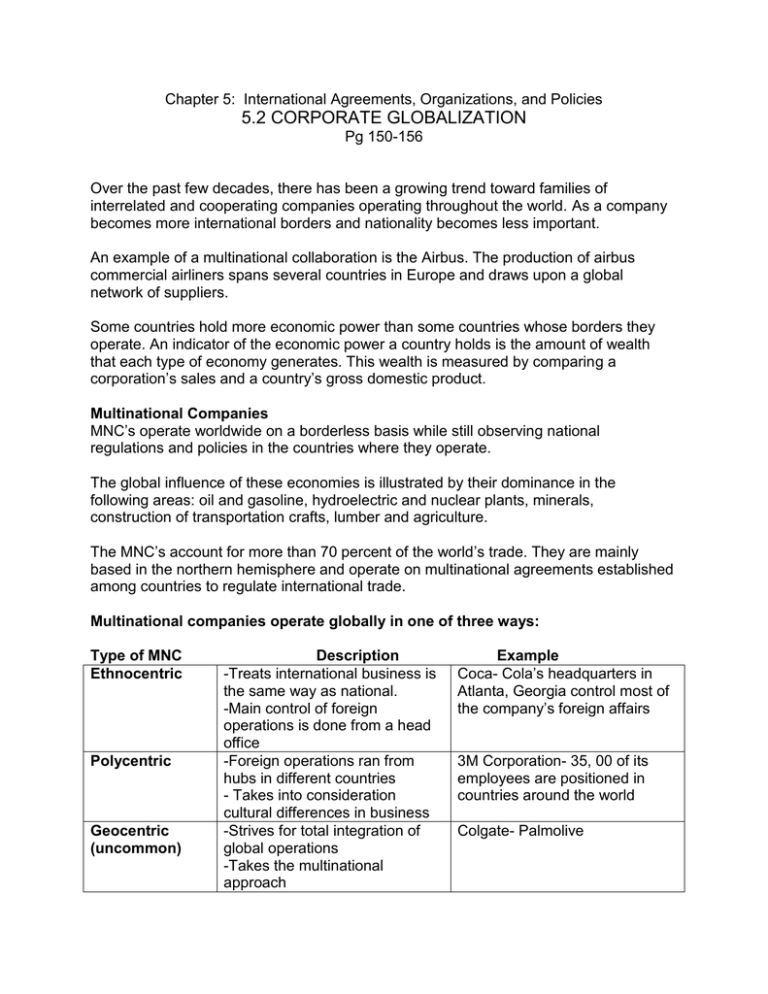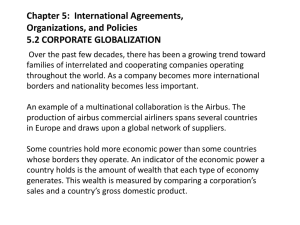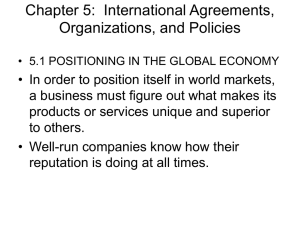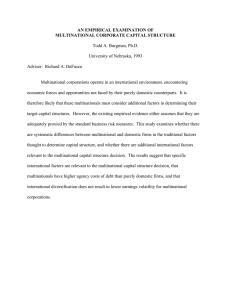5.2 CORPORATE GLOBALIZATION
advertisement

Chapter 5: International Agreements, Organizations, and Policies 5.2 CORPORATE GLOBALIZATION Pg 150-156 Over the past few decades, there has been a growing trend toward families of interrelated and cooperating companies operating throughout the world. As a company becomes more international borders and nationality becomes less important. An example of a multinational collaboration is the Airbus. The production of airbus commercial airliners spans several countries in Europe and draws upon a global network of suppliers. Some countries hold more economic power than some countries whose borders they operate. An indicator of the economic power a country holds is the amount of wealth that each type of economy generates. This wealth is measured by comparing a corporation’s sales and a country’s gross domestic product. Multinational Companies MNC’s operate worldwide on a borderless basis while still observing national regulations and policies in the countries where they operate. The global influence of these economies is illustrated by their dominance in the following areas: oil and gasoline, hydroelectric and nuclear plants, minerals, construction of transportation crafts, lumber and agriculture. The MNC’s account for more than 70 percent of the world’s trade. They are mainly based in the northern hemisphere and operate on multinational agreements established among countries to regulate international trade. Multinational companies operate globally in one of three ways: Type of MNC Ethnocentric Polycentric Geocentric (uncommon) Description -Treats international business is the same way as national. -Main control of foreign operations is done from a head office -Foreign operations ran from hubs in different countries - Takes into consideration cultural differences in business -Strives for total integration of global operations -Takes the multinational approach Example Coca- Cola’s headquarters in Atlanta, Georgia control most of the company’s foreign affairs 3M Corporation- 35, 00 of its employees are positioned in countries around the world Colgate- Palmolive Past trade only in a small region Today Huge success in international trade Different regions play specific roles in creating/ selling a product. It is common for multiple countries to be involved in making a single end- product. Triad- The unity between the USA, EU, and Japan. These three economies joined together create a huge power in the business world. Because their economies are so strong, it is hard for other countries to compete against them. To stay relevant, other countries must create freer trade agreements and lower their standards to give them an advantage against the Triad. Challenges to a Multinational Organization As these huge multinational organizations spread their influence around the world, they bring with them money, technology, know-how and skills. When a corporation invests in another country, there benefits are usually evident in jobs, the transfer of technology and training. The three regions in the Triad trend to work to the advantage of countries within their region, says Rugman, rather than encouraging true globalization by integrating other nations. The challenge to Canadian companies may now be to develop global customers beyond the Triad. At the moment, the great majority of our exports travel only as far as the United States. According to Rugman, it is also important for multinationals to be accountable and responsible for their actions. This means the jobs they create, as well as the technology, profits, and skills that they access in a host country, should stay in that country. Rugman points out another drawback to the way multinationals sometimes do business. Multinationals are creating global production systems, with parts, component, and assembly located in different countries. However, by deciding which jobs will be located in which parts of the world, they are creating new international divisions of labor. Global Organizational Structure The international marketplace is very unpredictable. It is different from the familiar comfort for domestic markets and customers. The stakes are high. International business experts agree that the question to ask is not “if” something will go wrong, but “when.” Caution along with good planning and organization, can help to minimize global problems. Large companies tend to be like large ships – it takes a long time to maneuver or change course. Therefore, it takes longer for them to analyze information and alternatives, and to maneuver around barriers and obstacles. This gives smaller, more responsive companies an actual advantage in the international marketplace. When this advantage is combined with benefits of technology, smaller companies can be very competitive with the bigger ones. Companies that are expanding internationally require an organizational structure that will accommodate their wider vision. Separate International Divisions International staff is isolated and function separately from the company. The international department has its own systems for sales, marketing, customer support, and logistics. This department handles all products going to all foreign markets. This structure can be quite efficient but has the potential disadvantage of requiring special plans for communication with the main operations of the company, which can cause delays. Functional Divisions The company maintains separate departments in sales, accounting, logistics, and research and development, with one or more individuals in each department responsible for handling international activities. This structure assures that employees work in their assigned professional or technical specialty and capacity. Product Division International and domestic activities are separated by product grouping. In this model, the division usually shares support or staff functions, such as accounting, with other divisions. Matrix Organization Though international staff may be separated according to function, product, or market responsibility, they are reporting flows across all departments. Matrix management allows more meaningful, more frequent, and more informal communication among staff and departments, but it is difficult to implement. Companies can choose among several possible structure that will suit their needs, size, and markets.



